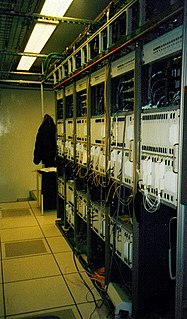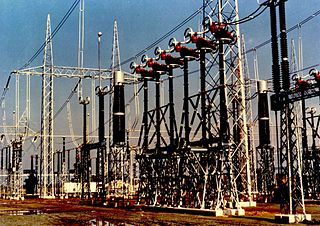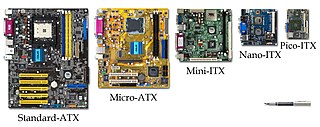Related Research Articles
In electronic design, a netlist is a description of the connectivity of an electronic circuit. In its simplest form, a netlist consists of a list of the electronic components in a circuit and a list of the nodes they are connected to. A network (net) is a collection of two or more interconnected components.

Synchronous optical networking (SONET) and synchronous digital hierarchy (SDH) are standardized protocols that transfer multiple digital bit streams synchronously over optical fiber using lasers or highly coherent light from light-emitting diodes (LEDs). At low transmission rates data can also be transferred via an electrical interface. The method was developed to replace the plesiochronous digital hierarchy (PDH) system for transporting large amounts of telephone calls and data traffic over the same fiber without the problems of synchronization.
A network switch is networking hardware that connects devices on a computer network by using packet switching to receive and forward data to the destination device.

Network topology is the arrangement of the elements of a communication network. Network topology can be used to define or describe the arrangement of various types of telecommunication networks, including command and control radio networks, industrial fieldbusses and computer networks.
A virtual circuit (VC) is a means of transporting data over a packet-switched network in such a way that it appears as though there is a dedicated physical link between the source and destination end systems of this data. The term virtual circuit is synonymous with virtual connection.

X.25 is an ITU-T standard protocol suite for packet-switched data communication in wide area networks (WAN). It was originally defined by the International Telegraph and Telephone Consultative Committee in a series of drafts and finalized in a publication known as The Orange Book in 1976.
A colocation center or "carrier hotel", is a type of data centre where equipment, space, and bandwidth are available for rental to retail customers. Colocation facilities provide space, power, cooling, and physical security for the server, storage, and networking equipment of other firms and also connect them to a variety of telecommunications and network service providers with a minimum of cost and complexity.

An application-specific integrated circuit is an integrated circuit (IC) chip customized for a particular use, rather than intended for general-purpose use. For example, a chip designed to run in a digital voice recorder or a high-efficiency video codec is an ASIC. Application-specific standard product (ASSP) chips are intermediate between ASICs and industry standard integrated circuits like the 7400 series or the 4000 series. ASIC chips are typically fabricated using metal-oxide-semiconductor (MOS) technology, as MOS integrated circuit chips.

A data center or data centre is a building, a dedicated space within a building, or a group of buildings used to house computer systems and associated components, such as telecommunications and storage systems.

A circuit diagram is a graphical representation of an electrical circuit. A pictorial circuit diagram uses simple images of components, while a schematic diagram shows the components and interconnections of the circuit using standardized symbolic representations. The presentation of the interconnections between circuit components in the schematic diagram does not necessarily correspond to the physical arrangements in the finished device.

Boundary scan is a method for testing interconnects on printed circuit boards or sub-blocks inside an integrated circuit. Boundary scan is also widely used as a debugging method to watch integrated circuit pin states, measure voltage, or analyze sub-blocks inside an integrated circuit.

In an electric power system, switchgear is composed of electrical disconnect switches, fuses or circuit breakers used to control, protect and isolate electrical equipment. Switchgear is used both to de-energize equipment to allow work to be done and to clear faults downstream. This type of equipment is directly linked to the reliability of the electricity supply.
A logical partition (LPAR) is a subset of a computer's hardware resources, virtualized as a separate computer. In effect, a physical machine can be partitioned into multiple logical partitions, each hosting a separate instance of an operating system.

IBM Z is a family name used by IBM for all of its z/Architecture mainframe computers from the z900 on.

A computer network is a set of computers sharing resources located on or provided by network nodes. The computers use common communication protocols over digital interconnections to communicate with each other. These interconnections are made up of telecommunication network technologies, based on physically wired, optical, and wireless radio-frequency methods that may be arranged in a variety of network topologies.

In integrated circuit design, physical design is a step in the standard design cycle which follows after the circuit design. At this step, circuit representations of the components of the design are converted into geometric representations of shapes which, when manufactured in the corresponding layers of materials, will ensure the required functioning of the components. This geometric representation is called integrated circuit layout. This step is usually split into several sub-steps, which include both design and verification and validation of the layout.
This glossary of computer hardware terms is a list of definitions of terms and concepts related to computer hardware, i.e. the physical and structural components of computers, architectural issues, and peripheral devices.

Electronic engineering is an electrical engineering discipline which utilizes nonlinear and active electrical components to design electronic circuits, devices, integrated circuits and their systems. The discipline typically also designs passive electrical components, usually based on printed circuit boards.
Shared risk resource group is a concept in optical mesh network routing that different networks may suffer from a common failure if they share a common risk or a common SRG. SRG is not limited to Optical mesh networks: SRGs are also used in MPLS, IP networks, and synchronous optical networks.

Form factor is a hardware design aspect that defines and prescribes the size, shape, and other physical specifications of components, particularly in electronics. A form factor may represent a broad class of similarly sized components, or it may prescribe a specific standard. It may also define an entire system, as in a computer form factor.